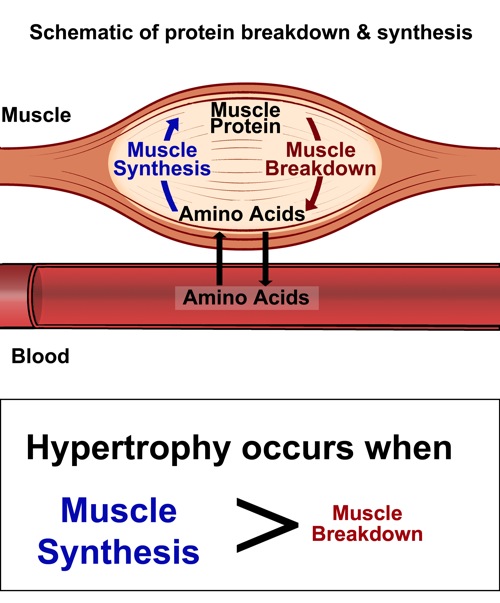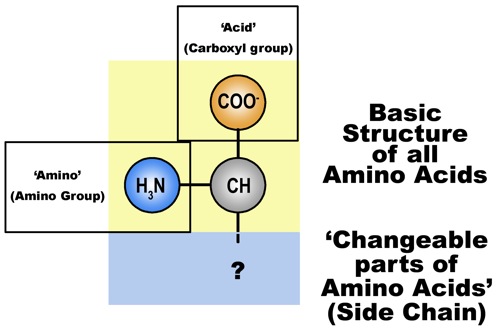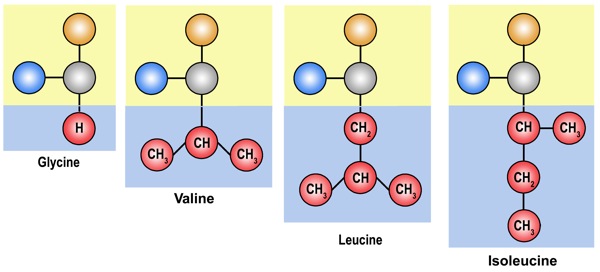When it comes to muscle building, leucine is the rock star of amino acids. It has its own VIP entrance to the cells, and the DJs mTOR and Rheb start the protein synthesis party when it arrives. But is leucine on its own better than whey?
Want bigger muscles? If so, you need to make sure you make more muscle (muscle protein synthesis) than you break down (Figure 1, below).
For this, you need two things:
- exercise (resistance training, that is) and
- amino acids (transported in blood).
The exercise wakes up the muscle to start making proteins.
Amino acids are the building blocks of muscle. If there are amino acids around, then off your muscles go to make more muscle. But if there are no amino acids, then no protein synthesis (more precisely, no net protein synthesis).
In the past few years, researchers have increasingly wondered what type of proteins/amino acids are best for muscle building during and after a workout.
First it was whey protein versus casein protein (or other proteins). In this case, whey comes out on top since the body can absorb the amino acids from whey more quickly.
Then people figured out that a specific type of amino acids — branched chain amino acids (BCAAs) — were better at making muscle.
Now it seems leucine (a specific flavour of branched chain amino acids) may be the key to muscle protein synthesis (making muscle).
What are amino acids?
If you take a look at Figure 2 below — my simplified artist’s rendering of an amino acid — you get an idea of what an amino acid is. I think of amino acids being made up of blocks with different shapes and types that snap together to make different types of amino acids.
You see, all amino acids have two specific blocks (groups):
- An amino group
- An acid (aka carboxyl) group
So together you get amino acids.
But there’s more: there’s the optional group that makes amino acids different from one another.
Personally, my favourite is glycine. Why? Well, say you had a biochemistry test and you had to draw glycine. All you would need to remember is the basic amino acid structure and an H (hydrogen). Take a look at Figure 2. Besides being my favourite, glycine is the simplest amino acid.
Other amino acids have different, more complicated, optional groups (usually called side groups). One sub-group of amino acids are branched chain amino acids (BCAAs).
What’s a branched chain amino acid?
While the simple glycine has a hydrogen as an optional group, branched chain amino acids have branched optional groups. Figure 3 below shows the shape of the three branched chain amino acids (leucine, isoleucine and leucine). You can see that there are a lot more of the CH3 (methyl groups) sticking out or branching.
What makes leucine special?
Why am I singling out leucine? You already know I have amino acid bias. But my biochemistry exams have nothing to do with why leucine is special. Leucine is special because it’s the rock star of amino acids… at least in muscle.
Leucine is the rock star of amino acids
Yes, leucine is the rock star of amino acids — it has its own VIP entrance into the muscle (cell) and it has pull with the club DJs. This is probably the easiest analogy to help you understand the world of the muscle cell.
All cells have a membrane to keep the inside stuff inside and the outside stuff outside. (Note: cell membranes are made mostly of fat [phospholipids] and part of the reason that it’s important to eat enough fat).
Along with the other BCAAs (and a couple other amino acids), leucine has is own VIP entrance (actually called LAT1). So leucine can get into the muscle easily.
Once leucine is in the club (cell) it can go up to the DJs (mTOR and Rheb proteins) who are responsible for getting the party (protein synthesis) started. So, mTOR and Rheb are all like, “Hey man, start protein synthesis!” (I’ll go into more details in another upcoming research review.)
So far, leucine is the only amino acid we know that’s able to directly trigger mTOR and Rheb. This makes leucine the rock star (or if you prefer, Paris Hilton, although I think that’s probably offensive to leucine).

Research question
Okay, so leucine is an amino acid rock star, but do you need more than what is already in whey protein? Is leucine better than whey for increasing protein synthesis and general muscle anabolism?
In this study, the researchers wanted to figure out if leucine increased the benefit of whey protein supplementation before exercise.
But there is one pretty big flaw. See if you can figure it out and I’ll tell you at the end. No cheating! Think of it as the game of Clue.
And no, it wasn’t Colonel Mustard in the conservatory with the candle stick.

This week’s study being reviewed is:
Tipton KD, Elliott TA, Ferrando AA, Aarsland AA, Wolfe RR. Stimulation of muscle anabolism by resistance exercise and ingestion of leucine plus protein. Appl Physiol Nutr Metab. 2009 Apr;34(2):151-61.
Methods
(No, it wasn’t Miss Scarlett in the kitchen with the rope.)
The usual suspects — err I mean participants — were recruited for this study. Healthy, young (25-30 years old), men (11) and women (4), but they had 5 years or more of regular resistance training (most likely weight training), which is a little more unusual. (Subjects are often untrained.)
The experiment had a few parts:
- 5 days before the test day, researchers figured out the participants’ 1 repetition maximum (1RM) for leg extension.
- The night before the test day, all participants went to a clinical research centre, ate a standard dinner, and then only had water until the start of the study the next morning.
- On test day, first thing in the morning (at the ridiculous hour of 5:45 am), venous and arterial blood were taken.
- Then, muscle biopsies of the vastus lateralis (muscle of the outside quads) were taken (about 50 mg of muscle).
- Participants consumed either the placebo (artificial sweetener, flavouring and water) or whey (16.6 g) and leucine (3.4 mg).
- Participants started leg exercises right after drinking the placebo or whey + leucine drink.
- The leg exercises used was a leg extension for 10 sets of 8 reps at 80% of 1RM with 2 min rest between sets (total time spent, about 35 min).
- Blood and muscle samples were taken throughout the leg exercise and after exercise.
Results
(Nope, it wasn’t Mrs Peacock in the lounge with the knife.)
Whey + leucine increased blood insulin levels
Insulin levels from just before drinking the placebo or whey + leucine drink until about 120 minutes after exercise, when insulin levels were back to baseline, were higher in the whey + leucine group.
How much higher? A hell of a lot: 1944mU/mL whey+leucine compared to 386mU/mL for the placebo (for those interested, this is a sum of the area under the curve from pre drink to 120 minutes post exercise).
In other words, blood insulin was over 5 times higher in the whey+leucine group compared to the placebo!
Raising insulin might seem like a bad thing, and most of the time, you don’t want high circulating insulin levels. But immediately after a workout, the muscles are uniquely sensitive to insulin’s effects. At that time, insulin will do its job most effectively — drive nutrients (e.g. protein) into the cells. So, for a very brief window, high insulin levels are OK.
Blood amino acids post drinks
Isoleucine, phenylalanine, leucine, lysine and threonine arterial blood levels all went up after exercise. Overall, these were higher (as calculated by area under the curve) in the whey+leucine group but there was no increase in any of the amino acids in the placebo.
So the whey+leucine drink increased arterial amino acids post-exercise (which is very important for protein synthesis in the muscle).
No difference in muscle amino acids between groups
Now, here’s an important distinction. Even though there was more amino acid in the blood of the whey+leucine group compared to the placebo, there was no difference in amino acid concentrations in the muscle (as measured by the biopsy).
I would guess this is because your muscle regulates how much amino acids it needs at any given time and brings more in as needed.
An analogy would be that the blood is a warehouse and the muscle in the retail store. The warehouse has all the “extra” stock that the retail store doesn’t need at the moment, but as soon as stock gets low, the store gets another delivery from the warehouse to stay topped up.
Conclusion
It was Professor Plum in the study with bad result interpretation.
What is clear from the study is that drinking 16.6 g of whey protein and 3.4 g of leucine right before resistance exercise simulates the muscle anabolic process compared to placebo. You have more amino acids available to the muscle (since the blood has more).
But the authors conclude that whey protein and leucine’s anabolic response is no different than whey protein alone by comparing a previous study (1).
Bottom line
Most of you have probably guessed what the flaw of this study is: the researchers didn’t have a whey-only group or a leucine-only group. How can you figure out if leucine enhances muscle anabolism if you don’t have a group without whey or without leucine?
Having a placebo group = good. Having a whey+leucine group = good. But you don’t have anything to compare the effect of leucine alone. You just know that whey+leucine is better than nothing.
The authors compare this study to another study they did with just whey (which has leucine) and say that the results are the same. Yeah, okay, this may be true, but that was a different time and there may be things that were different (unintentionally). They have shown that whey+leucine is better than nothing, but how much leucine has to contribute is still up in the air.
Knowing this group of researchers and their previous work, they will follow up on this study and definitely figure out if leucine has additional anabolic affects above whey.
References
Click here to view the information sources referenced in this article.
Learn more
Want to get in the best shape of your life, and stay that way for good? Check out the following 5-day body transformation courses.
The best part? They're totally free.
To check out the free courses, just click one of the links below.






Share